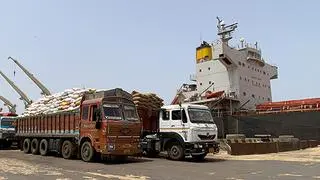The recent news reports about power raised many eyebrows; the unprecedented cancellation of passenger trains to run more freight trains to carry coal to power plants facing coal shortage, repeated announcements of large-scale power shedding and reports of disconnection of power supply by a distribution company to over 3,200 slum dwellers in Mumbai due to non-payment accrued dues of over ₹102 crore. After nearly a decade of stable power availability, the country saw widespread power cuts, even before the onset of peak summer season, which has now worsened in the present heat wave in large parts of the country.
There is a legacy of interdependence among coal, electricity and trains. Transportation was revolutionised in India when the British decided to connect ports of the Presidencies with the hinterland to facilitate military and commercial movement of raw material from hinterland to ports and import of finished goods in return.
Decades after the introduction of steam trains, Thomas Edison, invented the electrical incandescent lamp. He famously stated while demonstrating his invention, “We will make electricity so cheap that only the rich will burn candles” and later he also declared, “I’d put my money on the sun and solar energy. I hope we don’t have to wait until oil and coal run out before we tackle that.” Prophetic and paradoxical at the same time for India.
The Geological Survey of India, founded in 1851 by the East India Company, focussed on exploration of coal for powering steam transport and for the next 140 years or so Indian Railways (IR) burned billions of tonnes of coal to haul trains.
Although IR retired its steam locomotives by 1990s, 51 per cent of electricity in India is generated by burning coal in power plants, with coal transported mainly by IR. India is the third largest producer of electricity in the world with an installed capacity of about 400 GW. Notwithstanding the recent emphasis, renewable energy accounts for only 39 per cent (50 GW Solar, 46 GW Hydro and 40 GW wind). Coal for electricity is not only harmful for the environment, it is also inefficient; 400 gram of coal is burnt to generate every one unit of electricity (1kwh).
Project delays
So where exactly do we stand on green energy? The report ‘Delay in execution/completion of Power Project’ by Parliamentary Standing Committee on Energy (2020-21), Ministry of Power, observed that 12 out of 13 hydro-power projects suffered a total time over run of 1,205 months and cost overrun of ₹31,530 crore. Such delays in execution of renewable-energy projects may prolong our dependence on thermal power.
In respect of power scenario in the country, however, there is a double whammy. There are considerable time and cost overruns in completion of thermal projects too, development of coal mines, installation of efficient evacuation facilities by Coal India and capacity augmentation for faster transport of coal by IR. The common reasons for delays are much the same — environmental issues, land acquisition, rehabilitation and resettlement, capacity constraints and contract management. There is perhaps a need for greater political will as the bureaucracy in these core ministries seems to have proved unequal to align itself with the prime national goals.
Availability of power is a pre-eminent requisite for India to achieve the goal of $5 trillion economy and for this more capacities need to be built and utilised efficiently and the supply chain, even if is going to be coal, transported by IR for years to come, be managed effectively.
There is a case to look at the performance of power distribution utilities, many of which make losses for various reasons like poorly-thought out long-term power purchase agreements, poor infrastructure and inefficient operations.
This puts further constraints on them from investing to improve the quality of power supply and install required infrastructure for renewable energy, apart from the cascading ill-effects of non-payments to power generation entities. The NITI Aayog report of August 2021, ‘Turning around the Power Distribution Sector — Learnings and Best Practices from Reforms’ has estimated losses of the distribution sector of the order of ₹90,000 crore for FY 21.
In pre-pandemic 2019-20, India’s per-capita, annual power consumption was 1,208 kWh as against the world average of 3,260 kWh and far less than 10,000-15,000 kWh for developed countries. As our economy grows, with increase in industrial and manufacturing activities coupled with urbanisation, this number is bound to increase considerably.
The three interdependent entities, or a group of entities managing power, coal and Railways have to work in tandem with increased efficiency. IR must address the issue of faster transportation on dedicated corridors with efficient freight wagons. If these issues are not addressed, providing assured 24X7 power for all may elude us.
The rich may continue to have power from DG-sets but the less-privileged will be forced to use candles more often, which is an unacceptable, and, of course, a more expensive alternative.
Gupta is former, Member Public Enterprises Selection Board and Railway Board, and Mani is Retired General Manager/Indian Railways








Comments
Comments have to be in English, and in full sentences. They cannot be abusive or personal. Please abide by our community guidelines for posting your comments.
We have migrated to a new commenting platform. If you are already a registered user of TheHindu Businessline and logged in, you may continue to engage with our articles. If you do not have an account please register and login to post comments. Users can access their older comments by logging into their accounts on Vuukle.